Nature always ranks among the most popular photo subjects. Much of this appeal comes from our sense of wonder at the beauty of plants and flowers. Through photography, we can express this fascination and share it with others. Whether you enjoy shooting close-ups of a bud unfolding, or an entire mountainside of spring flowers in bloom, there are a number of ways to approach this type of photography. It may mean a trip to a botanical garden, setting up an arrangement of cut flowers, or simply exploring your own backyard. Another plus is that flowers don't move around, nor are they sometimes uncooperative like other subjects. Again, good lighting and composition are key to getting great images. Possibly the best light is the soft, diffuse illumination of open shade or a cloudy day. Like gardening, photographing flora and fauna can provide a peaceful and enjoyable communion with nature.
Most people try to include too much information in their photographic compositions. By contrast, you can see that this photo is more than a simple floral close-up—it's an elegant rendition of bold colors and lines against a dramatic black backdrop. A good photograph of any subject should show a single idea with as little clutter as possible. The photographer chose to crop this composition very closely, reducing it to its simplest form, yet in a way that's highly effective. There's an old saying in photography that says if you want to improve your images100%, then move closer, which is illustrated beautifully here. You can experiment with framing and cropping by shooting different compositions of a particular subject. Zoom in close and see how much you can eliminate from a photo. You may be surprised what powerful images you wind up with when you take risks and create a strong, graphic rendering of a scene. And when photographing bold colors like red and green, try using simple backdrops of black or white for added punch.
"I was photographing this tulip and was looking for a simple, yet elegant, composition. After about 10 shots, I tried to use a different approach. As I looked through the viewfinder, I knew I finally had my shot."
Canon EOS Digital Rebel
Canon EF 60mm macro lens
10 seconds at f/32
ISO 100
"Tulip"
© Robert Slachta
Dunmore, Pennsylvania http://bobslachta.photoworkshop.com
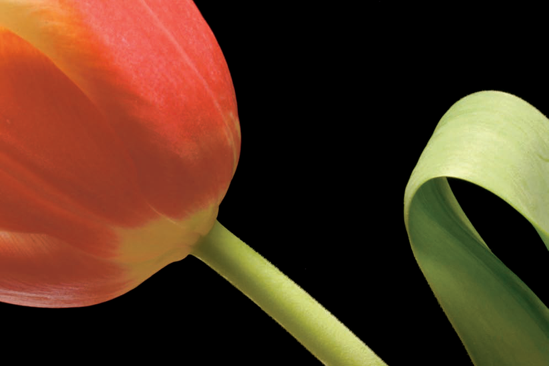
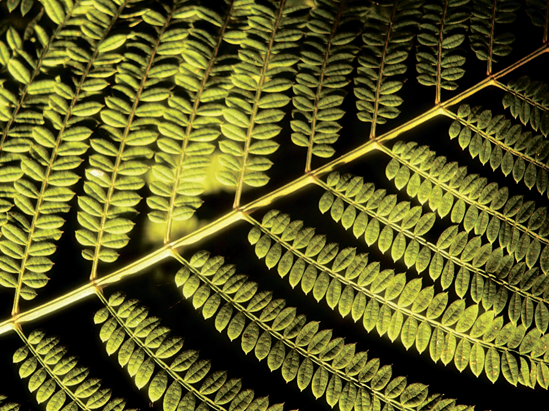
"Branch"
© Eduardo Magana Vazquez
Saltillo, Mexico www.eyefetch.com/profile.aspx?user=edumagana
The low light of early morning and late afternoon accentuates features and qualities of plants and flowers that are rarely noticed in full frontal lighting. Side lighting explores the intricate details of this fern's leaves, and the soft warmth of its color is another plus of early and late light. Compositionally, the pattern of the leaves with the diagonal line of the branch moving across the frame is very pleasing, and the dark background sets the illuminated frond off nicely. Shooting close-ups of flora and fauna opens a new realm for those who choose to explore it — you'll never look at a petal or leaf the same way again. The simplicity of the composition and the beautiful lighting is what elevates this image beyond a simple botanical recording.
"I like forms found in nature. One day I was pruning the trees in my garden, and I noticed how wonderful the light was on this particular branch. I immediately got out my camera and shot this scene."
Panasonic FZ20 compact digital camera
Auto exposure mode
Macro setting
Ambient daylight
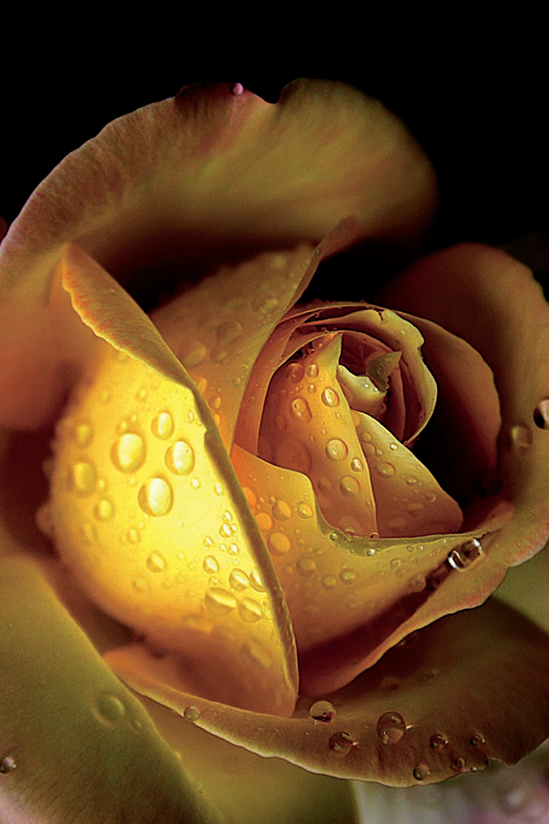
"Yellow Rose"
© Al Morrison
Akron, Pennsylvania http://amorrison.photoworkshop.com
Close-up images of flowers can be very striking, like this one, but also require some work on your part. Be aware that the closer your camera is to a subject, the shallower the depth of field becomes. Movement is also greatly exaggerated when shooting up close. A faint breeze can cause a flower to move around, so it's a good idea to try to block the wind from your subject whenever possible. You should use a tripod when photographing floral close-ups to reduce camera shake.
"This rose bush is kind of a scraggly mutt among the rose bush genre, not an especially prominent feature of our landscaping efforts. It doesn't receive the care and attention that it should probably get, yet it perseveres year after year, stubbornly rubbing against a drab cinder-block wall at the side of our garage. Shortly after an early afternoon spring rain, however, it spoke loud, proud, and clear with an offering that demanded to be photographed. This is lightly called a "Kodak" moment, but for me, it's as important as eating or breathing. Was it just a rose heavy with raindrops sitting at the side of a garage and visible only to a select few for mere nanoseconds? Perhaps, but I was inspired enough by the sight to capture it and can now relive the sweet serendipity of that moment whenever I want."
Canon EOS 300D Digital Rebel
Canon EF-S 18-55mm zoom lens
1/125 of a second at f/5.6
ISO 100
Morning light
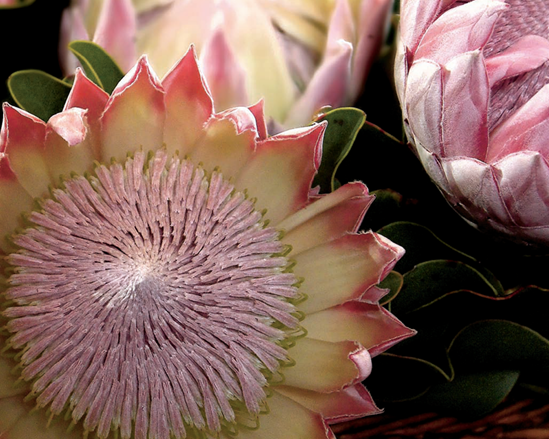
"Protea"
© James Lowell
Jacksonville, Florida
These close-ups of a Protea reveal the flower at a couple of different stages of bloom. Flowers provide enough diversity of color, shape, and patterns to keep nature photographers busy for a lifetime. In this shot, the photographer focused on the flower in full bloom in the foreground, and by using a large f-stop for shallow depth-of-field, the others are thrown slightly out of focus.
"I photographed this Protea in May when my wife and I were on a cruise vacation that included the city of Funchal, capital of Madeira, Portugal, in the city's central market, Mercado de Labradores. To enter the Mercado, I had to pass through a long, arched entry that led to the two-story inner courtyard and the main markets. It was about 10:00 a.m. when I arrived, and I had just reached the end of the archway entrance when I noticed a number of baskets of uniquely gorgeous flowers — including two varieties of African Proteas. The market was crowded, so I had to grab my picture between passing shoppers. The light coming in through the arch was less than ideal, but it was soft and sufficient enough to allow me to shoot hand-held while kneeling. Because of the low-light conditions, I had to use the camera's manual-focusing mode (I give much of the credit for sharpness to the lens' image-stabilizer).
Minolta DiMAGE A200 digital SLR
Minolta 28-200mm zoom lens set at 31.2mm
1/40 of a second at f/3.2
ISO 200
Ambient indoor light filtered through an archway
Patterns bring a sense of visual rhythm to a photograph as with this grouping of succulents. You can find patterns in any number of subjects: a field of flowers, faces in a crowd, or the designs in architecture. Patterns can be revealed when you examine subjects from varying angles. Shooting down from a high perspective can reveal these patterns, as it does here. At other times, the low light of morning and afternoon may etch out patterns in nature. You can also emphasize pattern and design in nature by isolating them from their surroundings with a telephoto lens. Rendering this scene in black-and-white emphasizes its graphic aspects.
"While I was traveling in San Francisco shooting images for my series, 'Botanica,' I came upon this scene and was immediately attracted to the concentric design of these plants (Echeverias). I liked the way the light and shadows brought out the form, which gave them a three-dimensional quality. These plants just had to be photographed. I chose black-and-white as a medium because of its abstract qualities."
Nikon D100 digital SLR
Nikkor 24–85mm lens set at 85mm
1/250 of a second at f/4.5
ISO 640
Daylight
"Botanica 4"
© Robert Cattan
White Plains, New York http://cattan.typepad.com/photography
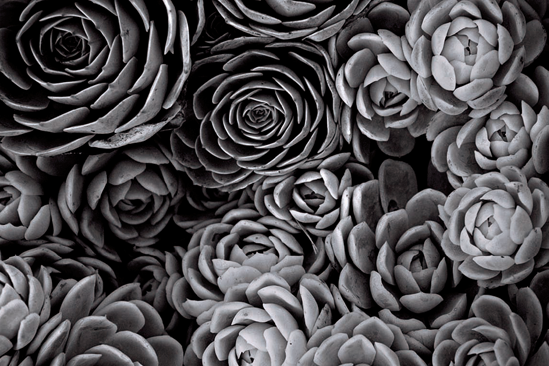
"The Palm"
© Gary Carter
McLeansville, North Carolina www.garycarterphotos.com
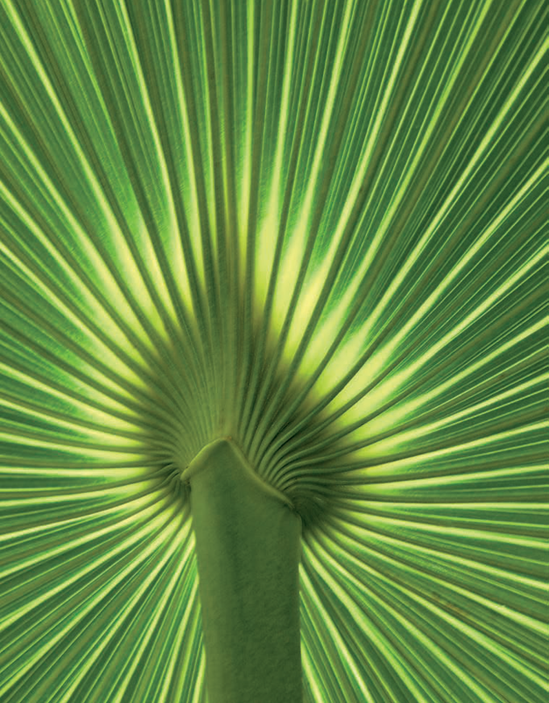
Here is another image that shows us the beauty of nature's intricate design. Our eye is drawn to the center of the photo, from which the lines of this palm leaf radiate outward beyond the frame. Nature's allure comes from the fact that we have a shared sense of wonder and mystery at the complexity found in nature. We don't admire photographs of plant life when they're ordinary botanical records, but rather, when they celebrate nature's beauty. Some natural subjects are rather close to the ground, so when you're shooting close-ups and need to use a tripod, be sure to choose one that is adjustable so that you can shoot near ground level. The sun backlighting this leaf makes it appear especially radiant.
"I shot this image in southern Georgia while I was staying at a motel. I walked around the motel grounds to see whether there was anything to photograph when I saw this palm frond and the sun behind it."
Canon EOS 1DS Mark II digital SLR
Canon EF 180mm macro lens
1/125 of a second at f/8
ISO 400
Gitzo tripod

"Calla Lily"
© Susan Bokos
Chappaqua, New York www.susanbokos.com
A simple backdrop was used to accentuate the color and flowing shape of this beautiful flower. Her floral choice and composition are excellent also, with the flower bending gracefully to the right, rather than choosing a flower in a more static position. The choice of black in the background against the brilliant orange and pink of the lily adds drama, and the overall image appears very painterly. Her use of a small f-stop (f/13) enabled her to fully capture the texture details, and the soft lighting coming from the side works beautifully. Off-camera flash or a well-placed studio light works great when shooting indoors.
"Most of my work has been portrait or documentary photography. As my love of nature, flowers, and gardening grew, I became interested in capturing that piece of my life in photos. I sought out flowers with beautiful, graceful lines and exquisite color — the simpler, the better. I was drawn to this calla lily first by its color, the rich orange with the blush of pink inside, and then by the graceful undulating lines of the flower and its stem. My aim was to capture this flower's strength and power, as well as its gentleness and flexibility."
Canon EOS 10D digital SLR
Canon EF 28–80mm zoom lens set at 63mm
6 seconds at f/13
ISO 100
Tripod
Smith Vector 10-inch 200-watt tungsten flood light, softened by hanging a plastic shower curtain in front of the light
You can really bring out the beauty of nature through the eye of a telephoto or close-up lens. And, as I've mentioned earlier, one of the pleasures of photographing flowers and plant life is that you may not have to look further than your own back yard, especially those of you who have a lovely garden. This photographer shot this colorful water lily in his pond at home with a telephoto zoom lens. And although there is an abundance of beauty in the natural world, you should focus on those subjects that hold particular interest for you. This photographer enjoys taking pictures of the flowers in his tropical garden, and even hopes to include these images in a book one day.
"Basically, this image is from a series that I have taken in my garden. Every morning between 9:00 and 10:00 a.m. when the light is great and the sun is still low in the Hawaiian sky, I take a few images. If a great one stands out from the rest, I include it in my 'Hawaiian Garden Collection,' which I hope one day to publish as a coffee-table book. This pink lily was photographed in my 120 × 60-foot Koi pond (I have three large lily ponds), around 9:00 a.m. This lily was freshly sprinkled with water from a passing tropical shower."
Canon EOS 5D digital SLR
Canon EF 70–300mm IS lens
1/25 of a second at f/5.6
ISO 100
Daylight
"Pink Lily"
© Peter McLaren
Paauilo, Hawaii www.woodshopgallery.com/Photography
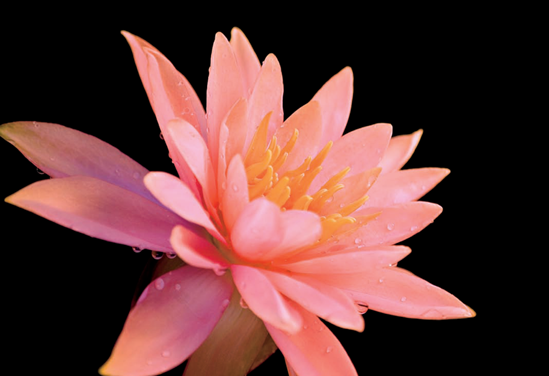
Many wonderful photo opportunities can be found in rural scenes, especially for those who can find interesting compositions. Rather than shooting the entire building, this photographer chose to isolate the green vine against the rusty brown veins of the cedar plank, resulting in a rich contrast of texture and color. This scene works especially well because of the soft, diffuse light, which is always a good choice when photographing plants. This flattering illumination wraps around the subject from many directions. Diffuse light also produces colors with greater saturation than with direct sunlight. Subtle tones and rich hues are beautifully reproduced, and primary colors are bold.
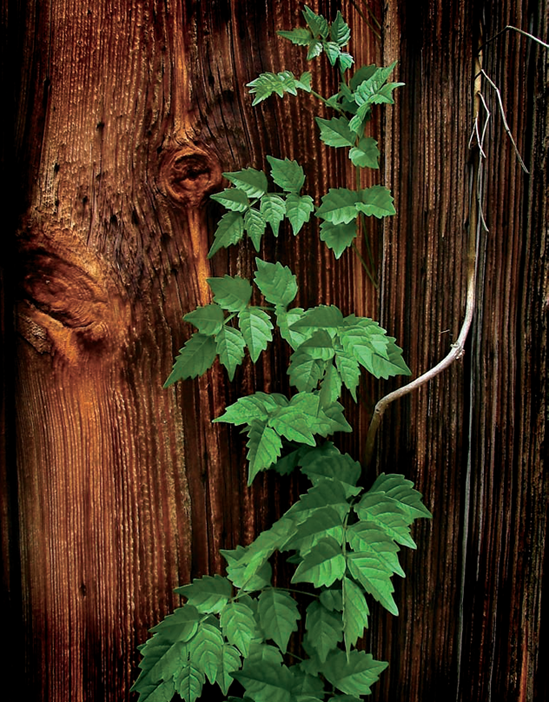
"Vine 2"
© Ricardo Santos
Laredo, Texas
"My family and I were spending the day at Gruene, Texas, which we enjoy visiting because of the historic sites. As we were about to return to San Antonio, I came across this scene. The green vine was highlighted as it clung to a cedar plank on an old building. The diffused light produced by the overcast skies provided a shimmering glow on the leaves and brought out the veins on the cedar board. I made just two frames of this scene, and we went on our way."
Fuji FinePix S5000 digital camera
Fujinon 5.7–57mm zoom lens set at 5.7mm
1/478 of a second at f/4.6
ISO 200
Diffuse light from an overcast day
"Margaritas"
© Jose Angel Diego Garcia
Asturias, Spain
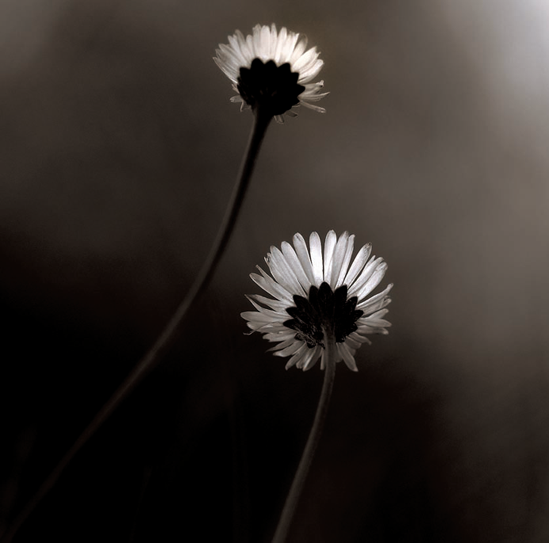
Your images take on a new perspective when you change your vantage point. Most of us confine ourselves to the typical point of view that a standing position gives us because it's convenient and seems natural, but you can make an image far more intriguing by changing your point of view. There are times when you may want to shoot from a lower, upward-looking vantage point to make the subjects appear taller and more majestic. With subjects like these flowers, you may need to lie down on the ground to shoot up. These flowers have gained in stature, becoming a looming presence against a dark sky.
"I have always appreciated images taken from an unusual point of view because I believe that our routines can prevent us from seeing the beauty around us. For this reason, I decided to view these humble daisies from the ground up — not from above shooting down as we would see them every day. After examining many of the daisies in this patch, I chose these two flowers because of their form, the way they reached toward the sky, and how their petals were illuminated. I had intended to make this a color photograph, but when reviewing it on the computer, it seemed as though the color worked against the flow and light on the flowers, so I chose to convert it to black-and-white with Capture NX software."
Nikon D70 digital SLR
Nikkor 105mm f/2.8 G VR lens
1/400 of a second at f/5.6
ISO 200
Sunlight
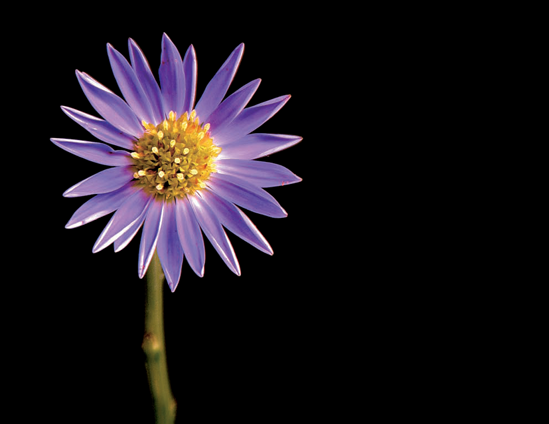
"Lonesome"
© Andrew Dykeman
New York, New York http://adykeman.photoworkshop.com
This dark background emphasizes the color and shape of a lone flower, and brings some drama to the image. I also like the fact that the subject is off-center in the frame. When choosing a point of view to photograph a floral subject, you'll want to find a viewpoint that reveals one or more of the plant's outstanding characteristics. Nonetheless, it's a good idea to experiment by photographing a subject from varying points of view and from high and low vantage points to see which angle works best. As for lighting, you'll want to position your light so that it comes from one side or behind the flower to show surface texture and the translucence of the petals. You can hold an electronic flash a few feet off-camera, or, as this photographer has done, use window light with a reflector to bounce light back at the subject.
"One of the great things about photography is its ability to reveal a subject in a manner we might not experience in our usual environment. With this in mind, I isolated this single flower against a black background so the viewer can enjoy its beauty with no distractions.
Canon Digital Rebel XT
Canon EF 28–135mm zoom lens set at 135mm
1/13 of a second at f/5.6
ISO 100
Window light and reflector with black fabric background
This view of a downcast sunflower is a departure from the typical floral rendition, in which we see flowers facing upwards toward the sun. Because she wanted to emphasize the solitary, downcast aspects of the flower, the photographer could have taken her pictures from further away, showing the flower in its environment. However, this close-up treatment provides a much more intimate view. Only a few petals close to the camera are in sharp focus, while the center of the flower and the petals on the far side are softly blurred. The light appears to be soft and diffuse, and the contrast of the bright yellow against the soft green of the background is pleasing. Colors often determine the emotional content of a photograph, and you can set the mood of an image by emphasizing particular colors. For example, blues and greens are peaceful and calm, whereas reds and oranges tend to be exciting and stimulating. The predominately yellow palette here imparts a feeling of warmth.
"It was late afternoon and I was shooting lovely sunflowers in the shade in my front yard. I looked to my right to choose another flower to photograph, and then I glimpsed this solitary sunflower with its head slightly bent over. I immediately saw my next shot. I whipped my camera and tripod around to capture this rather moody floral image."
Canon 5D digital SLR
Canon EF 100mm f/2.8 macro lens
1/200 of a second at f/5.6
ISO 200
Tripod
Open shade outdoors
"Sundown"
© Terry Ellis
Riverside, California http://terryellis.photoworkshop.com
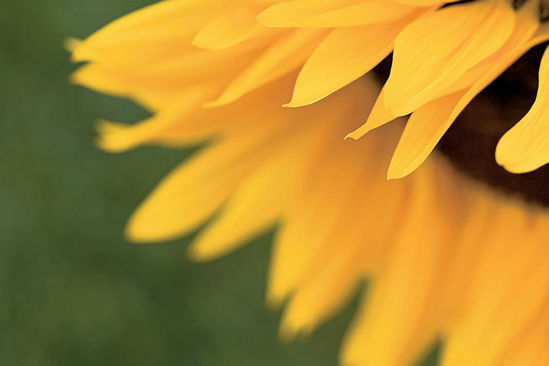
The graceful flower in the foreground would have been nice on its own, but the echo of the blurred tulip in the background creates added compositional interest. This image speaks to the importance of experimenting with different viewpoints and camera angles, which is very easy to do when working with inanimate objects like flowers. Curved lines in a photo are very effective as leading lines. Our eyes tend to follow a curved line into the picture and then stop at the end of the line. So these images are most effective when there's a subject at the end of the line worth looking at — in this case, the tulip. And, the photographer's low angle really makes the main subject appear stately and dynamic. Some tripods are adjustable so that you can get a very low viewpoint, but you can also try resting the camera on the ground or a tabletop. Use an off-camera flash to throw a little natural-looking light on the subject and a black background for a simple, yet dramatic, contrast.
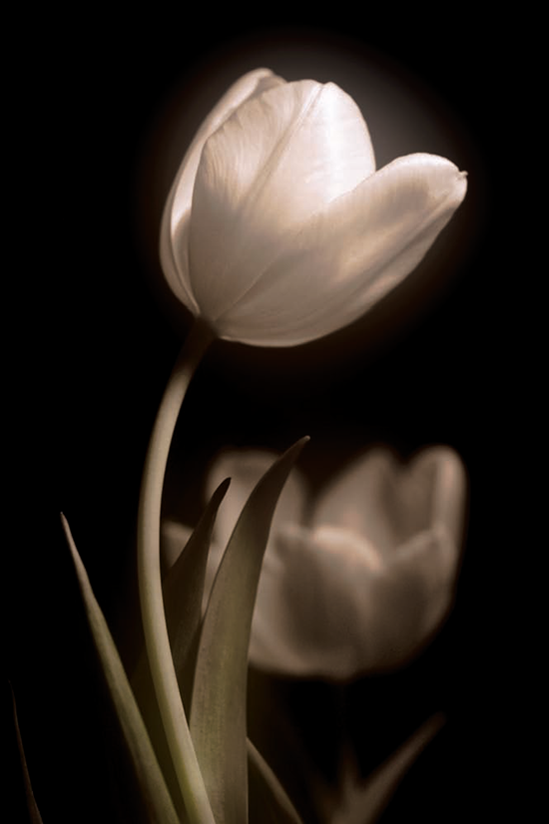
"Tulips"
© Ricardo de Masi
East Northport, New York http://rdmphoto.photoworkshop.com
"My wife had some wonderful tulips sitting in a vase for several days. I wanted to photograph them before they died, and see what kinds of images I could create. I took a series of photos, and experimented by shooting the flowers from all angles and a variety of flash positions."
Nikon D100 digital SLR
Nikkor 105mm f/2.8 lens
1/60 of a second at f/5.0
Hand-held flash with diffusion
This is one occasion when black-and-white just wouldn't have done justice to this beautiful flower that's bursting forth, making a bold, multi-colored statement. Although you can use off-camera flash to bring out colors, there are many times when natural light works very well, as in this case. This image was taken in early morning light. Try to avoid the harsh light of midday, as this illumination would wash out colors and create too much contrast. Drops from a recent rain (or even a sprinkler system) often add to the beauty of flowers. As with other close-up photography, be sure to fill the frame with your subject and use a shallow depth of field to blur the background, as this photographer has done. If you don't have a garden worthy of photographing, look for a local park or arboretum.
"This image was taken in my own garden, the perfect place for macro photography. On a damp summer morning I was looking for some damselflies when I saw this emerging flower. What interested me was the way it was blossoming, the raindrops, and the intense colors. Looking through my viewfinder, I noticed the perfect background and I knew I had a great image. I love working with simple, colorful compositions and a blurred background. For me, this was the perfect scene."
Canon EOS 1D Mark II digital SLR
Canon EF 100mm f/2.8 macro lens
1/125 of a second at f/8
ISO 100
Morning light
"Color"
© Bas Meelker
Groningen, The Netherlands www.basmeelker.nl

This backlit scene renders the water very bright, setting the water lilies apart from the background. Backlighting occurs when the sun or other light source is positioned behind the subject and shines directly at the camera. This type of illumination can be a very effective way to light a scene, but it's also difficult to expose, mainly because both the camera and the human eye don't like looking into the sun. Take your exposure directly off your subject, even if it means that the background will be a little washed out, and don't allow your meter to be fooled by the bright light coming in. On the plus side, contrast tends to be greater in backlit scenes than in others, and colors appear vibrant when the sun is low in the sky. You can also use backlighting to create silhouettes, simply by exposing for the background and allowing your subject to be dark.
"After shooting a variety of studio portraits, I wanted to do something different. I got a kick out of shooting flowers and trying backlighting. I took this image at the botanic garden at the University in Bergen. I still photograph flowers from time to time; it's so much fun to shoot them."
Canon EOS 10D digital SLR
Tamron 90mm f/2.8 macro 1:1 lens
1/800 of a second at f/8
ISO 100
Backlighting
"Water Babies"
© Atle Garmann
Bergen, Norway http://atlegarmann.photoworkshop.com
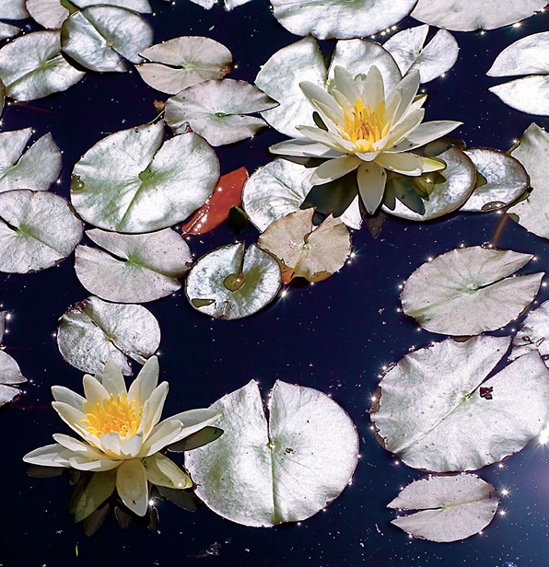

"Temptress"
© Terry Ellis
Riverside, California http://terryellis.photoworkshop.com
Capturing images of the natural world in a way that satisfies the photographer's vision can often be a challenge. You can sometimes achieve this with minimal equipment, but there are occasions when you'll want to use specialized camera and lighting equipment, such as the macro lens and studio lighting that this photographer used. She chose to focus solely on the stamen, which seems to beckon to us, throwing the rest of the flower into a red blur. A very shallow depth of field is imperative to achieve this effect, as is a good tripod to ensure image sharpness.
"This was a study of some lovely amaryllis bulbs that my husband grew for me to photograph. I wanted to capture the seductive, alluring quality of the stamens, leaving the rest of the flower soft and darkly mysterious. I do a lot of flower macro and still life photography, and have set up a mini-studio. I use a three-light soft photography lighting umbrella kit by Smith-Victor with a hair light and mini-boom. Two are 500-watt lights, and I position them on either side of my subject. Each light projects into a white umbrella. I moved the one on the right slightly forward and the one on the left slightly behind the subject for depth. The mini-boom is 250 watts and provides excellent backlighting. I also used a silver and gold mixed reflector to highlight the stamens."
Canon 5D digital SLR
Canon EF 100mm f/2.8 macro lens
1/4 of a second at f/5.6
ISO 100
Studio Lighting
This photographer was very successful in portraying the delicate details of the petals by using a small f-stop (in this case, f/16) and directional lighting. A simple white or black backdrop is often the best choice for accenting a flower's color or shape, and is less distracting than busy backgrounds. I like the way that she carefully chose a viewpoint and lighting to reveal the plant's outstanding characteristics — hence, "My Best Side." You can simulate sunlight by using an electronic flash held a few feet off-camera.
"The dahlia in this image was photographed against a Digitflash 1000 flat panel light in its modeling mode. I wanted the delicacy of the translucent petals with streaming color to the very tips. As I explored different angles in composition, I discovered the image as I turned the flower to its profile. I found the back of the flower to be equally as interesting as the front. 'My Best Side' came to mind with a little chuckle. The exposure was made with a center-weighted meter and I used a large white poster board reflector curved slightly around the flower. I chose to avoid using a light on the front in order to avoid shadows within the flower petals."
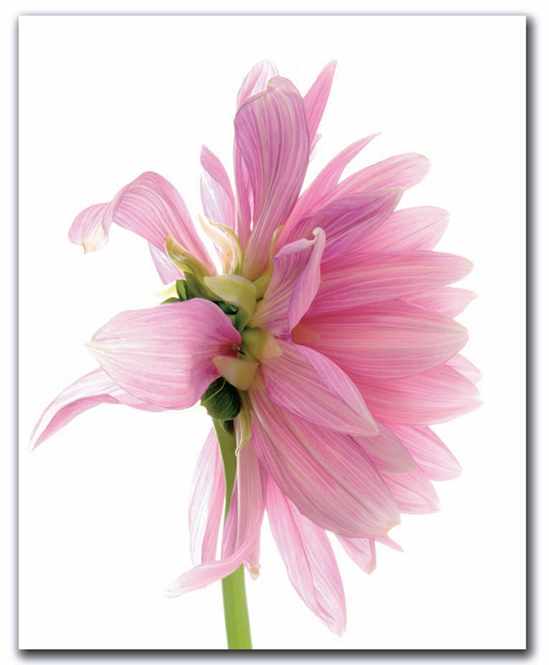
"My Best Side"
© Toni Martin
Lilburn, Georgia http://toni-martin-photos.photoworkshop.com
Nikon D2X digital SLR
Nikkor 24–85mm zoom lens set at 38mm
1/2 second at f/16
Exposure compensation +1.33
ISO 100
Digitflash flat panel light
Flowers provide enough diversity of color, shape and pattern to keep even the most prolific of photographers busy for a lifetime. This bold photograph reveals every detail of an exotic orchid. The lighting is direct, specular, and very effective for the rich color rendition of this flower. Be careful when lighting a subject from the front, because glare reflecting from the subject can sometimes produce a washed-out appearance. A small aperture (f/11) aids in rendering this entire subject in sharp detail, and the photographer utilized an aperture of1/60 because he was using flash. This photo stands in testimony that nature's designs can be truly amazing.
"I attended a recent International Orchid Show in San Francisco, California. Of the 300,000 orchids there, I rapidly captured as many of the unusual and photogenic orchids as possible in a three-hour period. But this one, Paphiopedilum, a sub-specie, stood out among the madding crowd. This vibrant, almost pulsating specimen that seemed half-plant, half-animal — almost wet with its colorful sheen — was the orchid du jour. The background was not befitting of this magnificent creature, so I replaced it with a black background so as to showcase the marvelous coloring of this orchid."
Fujifilm FinePix S602 digital camera, built-in lens
1/60 of a second at f/11
ISO 160
On-camera flash
Camera hand-held
"Venous-Orchidosa"
© Larry Reibstein
Aptos, California www.larryslens.com
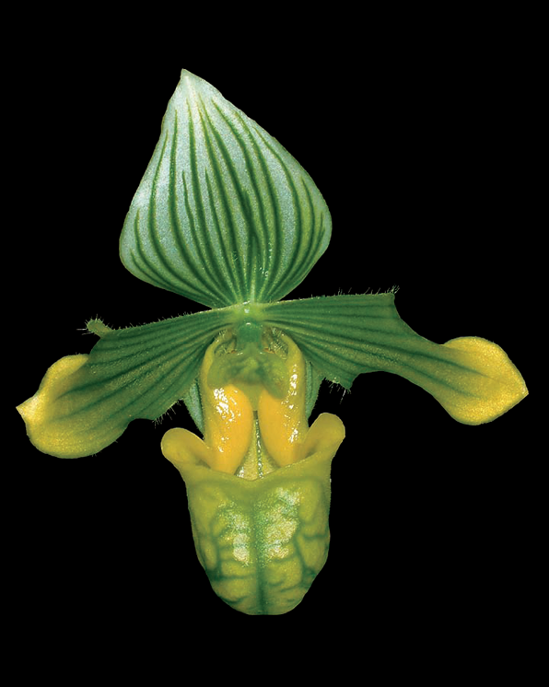
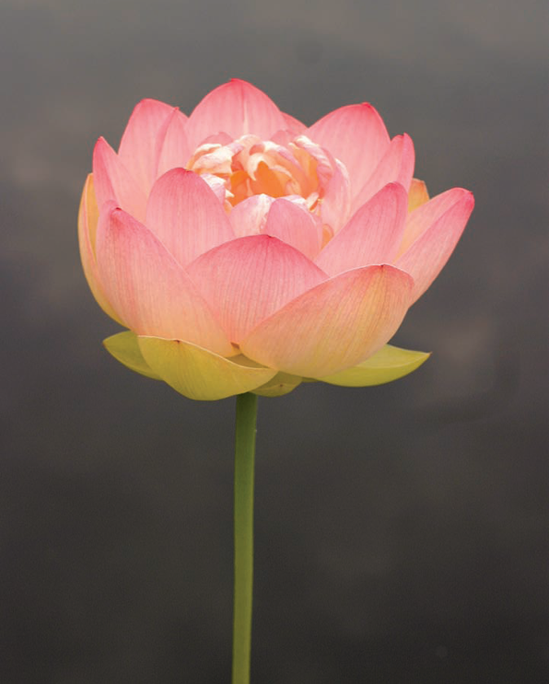
"Flower 4"
© Kenn Jensen
Tucson, Arizona www.kennjensen.com
This cheerful water lily seems as though it's illuminated from within, set against a dark backdrop. The contrast between light and dark makes this a very dramatic photograph. The lighting actually is the product of the soft and even illumination of an overcast day, which works well for floral and plant subjects. This photographer happened to find this scene when the light was right, but if you find a great subject and can't return to the scene later, there are still a few solutions you might try. For example, when shooting during the harsh light of midday, you can position some sailcloth, a white sheet, or other translucent material between your subject and the bright sun for diffusion. If you need more light, you can use an off-camera flash, positioned to either side of the flower or overhead.
"I took this water lily photo in August a few years ago, in Madison, Wisconsin. It was a cloudy day and the gray background is a reflection of the sky in the water. As I turned a corner, the exotic water lily dazzled my eyes and would not be denied. I stopped and shot over 20 images from various angles."
Canon 20D digital SLR
Tamron 28–75mm lens
1/125 of a second at f/6.7
ISO 100
Diffused light of a cloudy day
Besides being a lovely floral close-up, this image is appealing because the other columbines dance across the background of the frame in a soft blur of color. And the fact that this photographer positioned her main subject off to the right side of the frame is much more pleasing to the eye than had she placed it dead-center. As a general rule, putting the main point of interest in the middle of the frame often creates a static composition that doesn't hold the viewers' attention for very long. When you're out shooting pictures of wildflowers, try varying your viewpoint by moving around your subject, or by zooming in and out with your lens for compositional variety.
"Imagine being in the Rocky Mountains of Colorado. The mountaintops are covered with snow from the harsh winter. However, the warmth of the spring sun is renewing that hibernated, gray winter life. Bears are coming out of their dens while the chirping birds are nesting to form new life. While walking along the foothill paths, you stumble upon these beautiful flowers, the Colorado Columbines (also known as Rocky Mountain Columbines). This flower that is so delicate and soft with muted blue and yellow colors is the official state flower. Nature's little wonders are inspiration enough to stop and take this picture. Keep your eyes open to things we may take for granted."
Canon 5D digital SLR
Canon EF 24–105mm L f/2.8 zoom lens set at 105mm
1/160 of a second at f/4
ISO 250
Spot metering
Natural daylight
"Colorado Columbines"
© Bea Friedli
Oyster Bay, New York http://beafriedli.photoworkshop.com
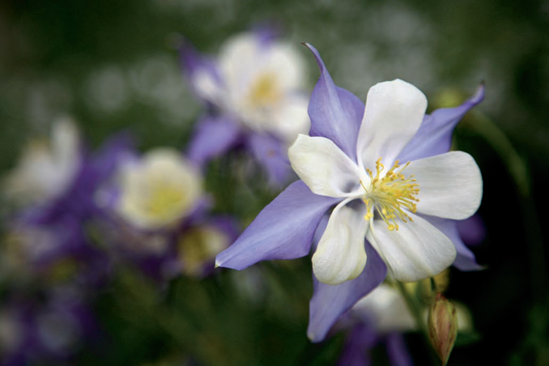
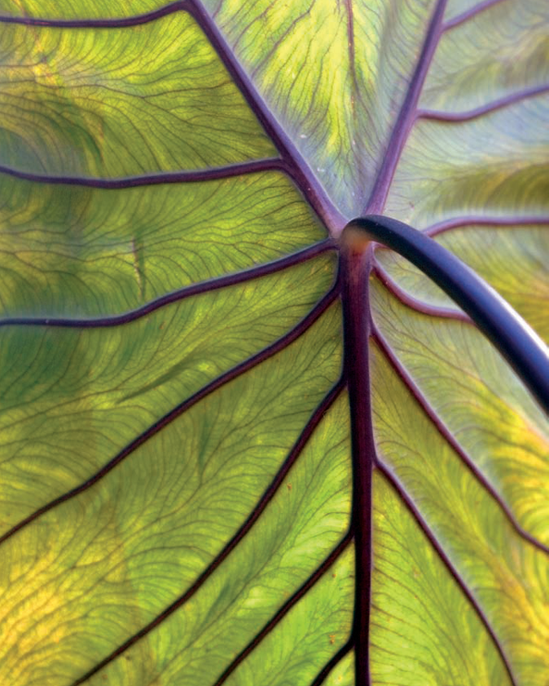
"Elephant Leaf"
© Paul Hippauf
Napa, California
Remember that not every photograph you take must be a literal translation of the subject. After shooting pictures of a group of plants, get closer and concentrate on shooting the intriguing designs of a single leaf. Striking images can emerge from confluences of color, shape, texture, and form that comprise the larger scene. The secret to capturing powerful details is the ability to isolate them, extracting the components of your images from their surroundings in such a way that the design — and not the total object — becomes your subject. This photographer explored the designs of this Elephant Ear nicely, and the backlighting enhances its color and texture.
"I often give myself assignments when I go out to shoot, like taking one picture every five minutes, or using just one lens. This time I set out to capture details. I had actually just finished shooting something else and then spun around and saw this leaf. It was backlit by the sun and just jumped out at me. I set up my tripod, steadied the leaf in the wind, and took a few shots. This is the one I liked best — I still find myself staring at all the detail that I captured in this image. You've probably heard this adage before; 'always turn around and look behind you.' Sometimes I'll take a trail, then return the same way and discover things I didn't see before."
Canon EOS Digital Rebel XT
Canon 28–105mm EF zoom lens set at 63mm
1/125 of a second at f/4.0
ISO 100
Ambient daylight
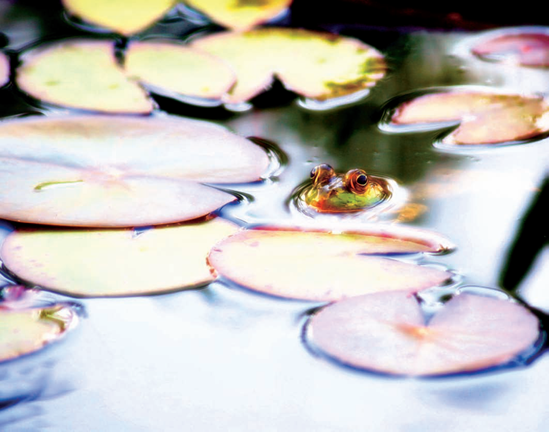
"Frog & Lily Pads"
© Eric Phillips
Camby, Indiana http://picasaweb.google.com/ericandamos
The long end of a telephoto zoom focuses on a frog poking its head up in a lily pond. In addition to offering a shallow depth of field — thus throwing the background out of focus and accenting the subject —a telephoto lens enables you to keep your distance from skittish subjects in nature. One good zoom lens with a wide range of focal lengths can be a valuable addition to your camera gear, especially if you don't want to tote around a lot of lenses. On most digital cameras, the focal length of lenses is multiplied by a factor of 1.6, so the 200mm focal length used here effectively becomes 320mm. This photographer had to react quickly to capture the subject, and I like the way that the out-of-focus lily pads provide framing around the colorful frog's head, which in contrast, is in very sharp focus.
"I was taking photos of water lilies in my small garden pond and the frogs would suddenly pop their heads up out of the water. There was no wind and the reflections from the flowers and the sky made the water appear to be a kaleidoscope. The frogs were so brilliantly green with the water glistening on them."
Canon EOS 20D digital SLR
Tamron 50–200mm zoom lens set at 200mm
1/100 of a second at f/5.6
ISO 100
Ambient outdoor light
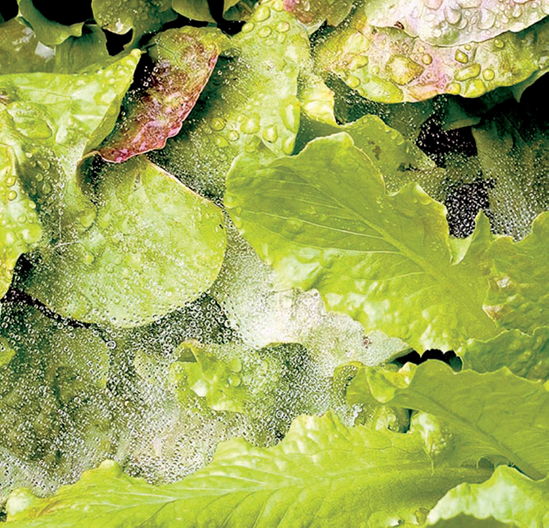
"Lettuce in the Rain"
© Ian Murray
Weymouth, Massachusetts
This image is a beautiful study of contrasting textures and color that create a beautiful design. And because it's photographed from above, it also appears to be a harmonious still life. Photographing a subject from a high angle also eliminates a cluttered background. In many cases when you're looking for a portable high-angle platform, a ladder will do nicely.
"My dear wife is a landscape designer and avid gardener, so I get plenty of opportunities to photograph nature's handiwork. I steer clear of planting, but I've delivered presentations to garden clubs on 'Photographing Your Garden,' using a slideshow of my images. One key question that would-be garden photographers ask is, 'What is the best time to photograph the garden?' and my answer is always, 'any time.' To prove it, I've taken pictures at different times of day, in all seasons and weather conditions. This image of lettuce is one I have used to demonstrate the impact of water droplets on the plant you're photographing. It also doubles as an example of how to use rainfall to good effect. I took it early one rainy morning in July, but by holding the camera in one hand and an umbrella in the other, I was able to get the shot of the spider web and rain droplets."
